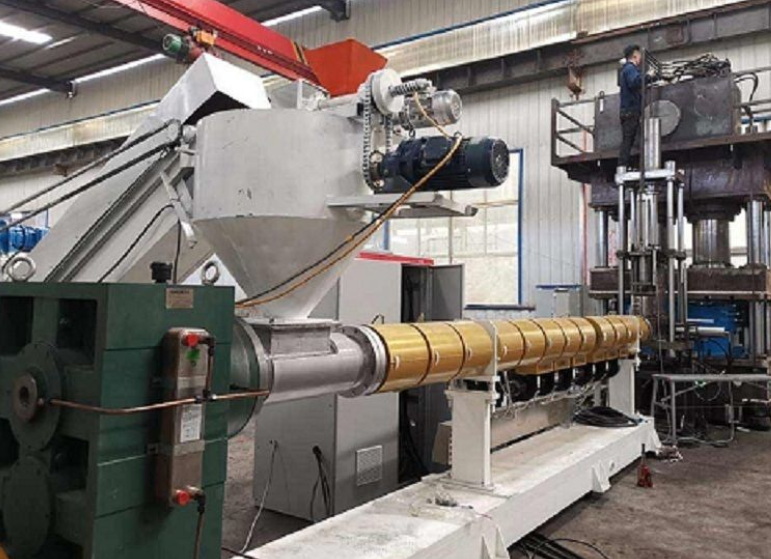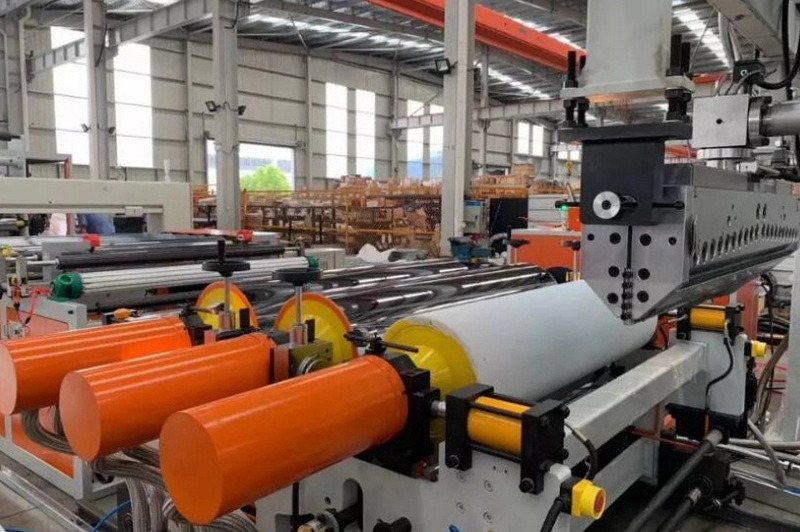Content Menu
● Understanding Second-Hand Plastic Extrusion Machinery
● Why Inspect and Test Second-Hand Plastic Extrusion Machinery?
● Step-by-Step Guide to Inspecting Second-Hand Plastic Extrusion Machinery
>> 1. Visual and Physical Inspection
>> 2. Review Documentation and Machine History
>> 3. Mechanical and Functional Testing
>> 4. Lubrication and Wear Assessment
>> 5. Environmental and Safety Compliance Check
● Testing Checklist for Second-Hand Plastic Extrusion Machinery
● Tips for Buying Second-Hand Plastic Extrusion Machinery
● Maintenance Recommendations After Purchase
● Conclusion
● FAQ
>> 1. What are the key components to inspect on second-hand plastic extrusion machinery?
>> 2. How can I test the functionality of a used plastic extruder before purchase?
>> 3. What documentation should I request from the seller?
>> 4. How often should maintenance be performed on plastic extrusion machinery?
>> 5. Are there benefits to buying refurbished plastic extrusion machinery over used?
● Citations:
Purchasing second-hand plastic extrusion machinery can be a cost-effective way to expand or start plastic manufacturing operations. However, these machines require careful inspection and testing to ensure reliability, safety, and performance. This comprehensive guide will walk you through the essential steps to inspect and test second-hand plastic extrusion machinery, helping you make an informed investment that meets your production needs.

Understanding Second-Hand Plastic Extrusion Machinery
Second-hand plastic extrusion machinery refers to pre-owned equipment used to melt and shape plastic materials into continuous profiles such as pipes, sheets, films, and more. These machines include key components like the extruder screw and barrel, heating and cooling systems, motors, drives, and control panels. Because extrusion machinery is complex and subjected to wear, thorough inspection is critical before purchase.
Why Inspect and Test Second-Hand Plastic Extrusion Machinery?
- Cost Efficiency: Used machines cost significantly less than new ones, but poor condition can lead to costly repairs or downtime.
- Safety: Ensuring safety features are intact protects workers and complies with regulations.
- Performance Assurance: Testing confirms the machine's ability to produce quality products consistently.
- Longevity: Inspection reveals the remaining service life and helps plan maintenance.
Step-by-Step Guide to Inspecting Second-Hand Plastic Extrusion Machinery
1. Visual and Physical Inspection
Start with a thorough visual check of the machine's overall condition:
- Exterior Condition: Look for cracks, rust, dents, scratches, or signs of fluid leaks such as hydraulic oil or water. These indicate possible neglect or damage.
- Key Components: Examine hoses, wires, cables, and connectors for wear, disconnections, or missing parts.
- Transmission System: Inspect gears, bearings, and drive belts for wear or damage.
- Hydraulic System: Check for leaks, pressure integrity, and condition of hydraulic cylinders.
- Electrical Components: Verify that circuit boards, switches, and wiring are intact and not corroded or damaged.
- Heating Elements: Inspect heater bands and temperature sensors for wear or malfunction.
- Safety Features: Confirm all emergency stops, guards, and safety interlocks are present and functional to comply with OSHA or relevant standards[1][6].
2. Review Documentation and Machine History
Request detailed information from the seller:
- Machine Make, Model, and Year: Helps assess technology and parts availability.
- Operating Hours and Cycles: Indicates usage intensity and wear.
- Maintenance Records: Shows how well the machine was cared for and what repairs have been done.
- Previous Applications: Know what plastics were processed to anticipate contamination or wear issues.
- Warranty and After-Sales Support: Understand if any warranty remains or if technical support is available[5].
3. Mechanical and Functional Testing
Once satisfied with the visual inspection, proceed to test the machine's operation:
- Power Up and Motor Check: Turn on the machine and observe the motor's startup behavior. Check voltage and current to ensure they are within rated specifications.
- Screw and Barrel Condition: The screw should rotate smoothly without abnormal noises or vibrations. Check for wear on the screw flights and barrel interior.
- Heating and Temperature Control: Verify that heating zones reach and maintain target temperatures accurately. Temperature sensors and controllers must be responsive and stable.
- Drive and Die Performance: Confirm the drive system operates without jerks or slips. Inspect the die for damage or clogging.
- Product Quality Test: Run a short extrusion trial with the intended plastic material. Inspect the extruded product for uniformity, surface finish, and dimensional accuracy[4][7].
4. Lubrication and Wear Assessment
- Lubrication Points: Check all lubrication points and apply grease or oil as needed to ensure smooth operation.
- Wear Measurement: Use appropriate tools to measure wear on critical parts such as bearings, gears, screws, and barrels. Replace parts that exceed wear limits to avoid breakdowns[3][6].
5. Environmental and Safety Compliance Check
- Work Environment: Assess the machine's installation environment for cleanliness and adequacy of ventilation and lighting.
- Noise and Vibration Levels: Excessive noise or vibration may indicate mechanical problems.
- Safety Compliance: Confirm compliance with safety standards, including guards, emergency stops, and operator training requirements[1].

Testing Checklist for Second-Hand Plastic Extrusion Machinery
| Inspection Aspect |
What to Check |
Importance |
| Visual Condition |
Rust, cracks, leaks, missing parts |
Prevents hidden damages |
| Electrical System |
Wiring, circuit boards, motor voltage/current |
Ensures reliable operation |
| Mechanical Components |
Screw, barrel, gears, bearings |
Affects product quality and uptime |
| Heating & Cooling Systems |
Temperature control accuracy, heating elements |
Maintains extrusion process |
| Safety Features |
Guards, emergency stops, interlocks |
Worker safety and compliance |
| Documentation |
Maintenance history, operating hours, warranty |
Predicts future maintenance needs |
| Trial Run |
Product quality, machine stability |
Confirms production capability |
Tips for Buying Second-Hand Plastic Extrusion Machinery
- Buy from Reputable Sellers: Choose vendors with industry experience and good reviews.
- Request Machine Demonstrations: Videos or live demos show the machine in operation.
- Consider Refurbished Options: Refurbished machines often come with replaced worn parts and warranties.
- Plan for Spare Parts: Ensure availability and cost of replacement parts.
- Negotiate Terms: Discuss warranty, return policy, and installation support.
Maintenance Recommendations After Purchase
- Perform regular inspections after installation.
- Follow manufacturer's guidelines for lubrication and part replacement.
- Monitor machine parameters like temperature, pressure, and motor load.
- Schedule preventive maintenance after every 2,500–5,000 hours of operation.
- Address abnormal noises or alarms immediately to avoid major failures[3][7].
Conclusion
Inspecting and testing second-hand plastic extrusion machinery is a critical process that can save you from costly repairs, production downtime, and safety hazards. By conducting a thorough visual inspection, reviewing machine history, performing mechanical and electrical tests, and verifying safety features, you can confidently select machinery that meets your production requirements. Proper maintenance following purchase will extend the machine's life and ensure consistent product quality. Investing time and effort in this process maximizes the benefits of acquiring second-hand plastic extrusion machinery.

FAQ
1. What are the key components to inspect on second-hand plastic extrusion machinery?
Key components include the extruder screw and barrel, transmission system (gears and bearings), hydraulic system, heating elements, electrical wiring, and safety features such as emergency stops and guards[1][6].
2. How can I test the functionality of a used plastic extruder before purchase?
Power up the machine to check motor operation, verify temperature controls, observe screw rotation for smoothness, and run a trial extrusion to inspect product quality and machine stability[4][7].
3. What documentation should I request from the seller?
Ask for the machine's make, model, year, operating hours, maintenance records, previous plastic materials processed, and warranty or after-sales support details[5].
4. How often should maintenance be performed on plastic extrusion machinery?
Regular maintenance is recommended every 2,500 to 5,000 hours of operation, including inspection, lubrication, wear measurement, and replacement of worn parts[3].
5. Are there benefits to buying refurbished plastic extrusion machinery over used?
Refurbished machinery often has replaced critical worn parts, tested operation, and sometimes comes with a warranty, providing higher reliability than typical used machines sold as-is[6].
Citations:
[1] https://plastiwin.com/uncategorized/plastics-machinery-inspection-purchase-checklist/
[2] https://jiantai.io/used-plastic-extrusion-machines/
[3] https://www.polytechmachine.com/info/daily-maintenance-of-plastic-extrusion-product-97684149.html
[4] https://surplusrecord.com/buying-guides/extruders/
[5] https://www.arlingtonmachinery.com/blog/p.220602001/top-5-questions-to-ask-when-purchasing-used-plastics-machinery/
[6] https://www.usedextruder.com/325.html
[7] https://www.taizhengmachine.com/regular-inspections-and-emergency-solutions-of-plastic-extrusion-machine.html
[8] http://extrusionwiki.com/wiki/CC-V22-2-D.ashx
[9] https://www.caisumachinery.com/how-to-choose-a-used-pvc-sheet-production-line/
[10] https://www.linkedin.com/pulse/winter-extruder-maintenance-checklist-lily-xu
[11] https://reads.alibaba.com/your-ultimate-guide-to-sourcing-plastic-extruders/
[12] https://plasticextrusiontech.net/quality-control-and-testing-procedures-in-plastic-extrusions/
[13] https://www.indext.fr/en
[14] https://registers.worksafe.govt.nz/dmsdocument/554-plastics-extrusion-presses
[15] https://blog.machinepoint.com/en/how-to-buy-used-machinery/
[16] https://www.cowinextrusion.com/all-about-plastic-extrusion-and-helpful-tips-for-buying-extruder-machinery/
[17] https://www.youtube.com/channel/UCp69OzfOR2zEFfDQLtakoNQ/about
[18] https://plastiwin.com/uncategorized/plastic-extrusion-process/
[19] https://pubhtml5.com/iimu/fsea/
[20] https://www.alibaba.com/showroom/used-extruder-equipment.html






















